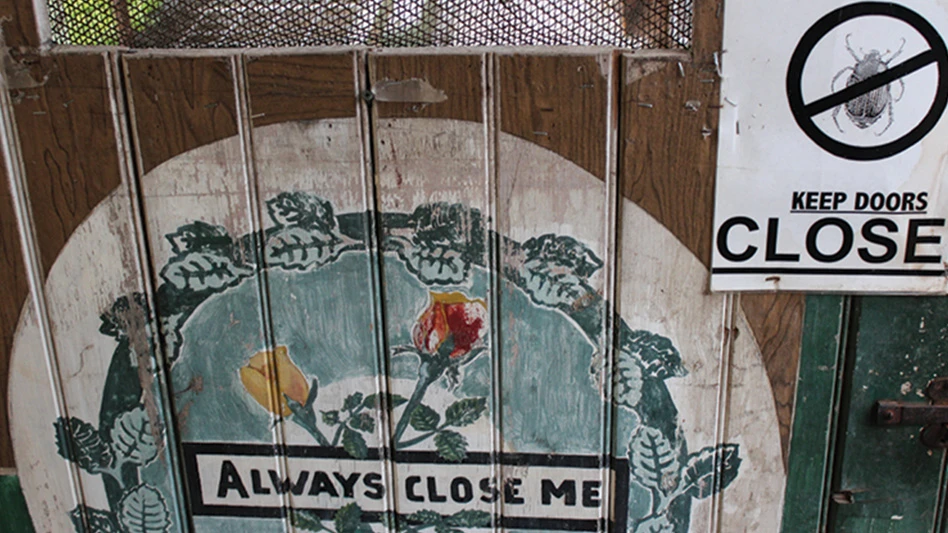
Early detection and accurate identification of pest problems is fundamental to producing high-quality crops and maintaining a successful business. This is best accomplished by implementing a scouting program with individuals dedicated to monitoring and capturing information about pest problems and overall plant health.
Scouting is the regular, systematic inspection of crops and growing areas for early detection and identification of pest/disease problems. This information enables growers to respond appropriately and more quickly, resulting in reduced plant damage, improved product quality, reduced production costs and fewer production delays. Continuous detection efforts and accurate record keeping help increase our ability to anticipate and schedule activities related to future pest management issues. A scouting program directly supports and contributes to improved product quality, reliability and customer satisfaction.
Scouting tips
- 1. Assess the overall health of the crop.
- 2. Look for chlorotic (yellow), stunted or malformed growth and obvious signs of plant damage.
- 3. If there is an obvious problem, inspect affected plants first and record information.
- 4. Take a sample if diagnostic assistance is needed.
- 5. Inspect plants from the front, middle and back of bed. The quantity of plants sampled will depend upon the size of the crop on the bench and whether you have just one plant species on the bed or multiple species.
- 6. Check at least three leaves per plant and 10 plants per 1,000 sq. ft. for each plant species grown.
- 7. Examine top, middle and bottom canopy of plants, being sure to look at the undersides of the leaves for signs of insect problems.
- 8. Carefully dislodge the plant from its container and inspect the root system.
- 9. Alternate the scouting pattern each week to keep your inspection random.
Check plants for thrips and other invertebrate pests by gently tapping the terminal, foliage and/or flowers over a white sheet of paper or other collecting surface. This will dislodge them, making it easier for you to observe and identify their presence.

Taking samples
Label a small plastic bag with the location, plot number, item number and variety of the sample taken. As a rule, if the problem is localized (i.e. feeding damage) only the affected area needs to be sampled. If the entire plant appears affected, then a sample including the root system is suggested.
Yellow card monitoring
Monitoring with sticky cards allows you to assess what flying pests are near the crop. The cards should be placed just above the plant canopy and should be inspected and changed on a regular basis. Typically, sticky cards are inspected and replaced on a three to seven-day interval. If thrips are of primary concern, then blue sticky cards are useful.
Symptoms and signs of key insect pests:
- Aphids – Check plant terminals and undersides of young, tender leaves. Look for cast skins and black sooty mold on lower leaves.
- Thrips – Inspect flowers and young foliage. Look for scarring on new, tender foliage and irregular white spots that give the leaf or flower a white or silvery, stippled appearance. Flowers will be deformed and discolored, while new growth will appear distorted or crinkled with feeding scars.
- Whiteflies – Check undersides of leaves for signs of immature stages and the upper surface of lower leaves for black sooty mold.
- Twospotted spider mites – Check for yellow-white stippling of foliage that may look like initial signs of nutritional problem. Inspect undersides of foliage for presence of pests or webbing.
- Fungus gnats and shore flies – Look for adults on the foliage and the roots and lower stem for larvae (clear, worm-like body with a shiny black head capsule).
- Lacebugs – Inspect undersides of leaves for this insect pest. Feeding causes upper leaf surfaces to have a silvery, speckled appearance.
- Leafminers – Look for small serpentine mines on plant foliage.

Explore the December 2016 Issue
Check out more from this issue and find your next story to read.
Latest from Produce Grower
- AmericanHort accepting applications for HortScholars program at Cultivate'25
- BioWorks hires Curt Granger as business development manager for specialty agriculture
- Bug budget boom
- Don’t overlook the label
- Hurricane Helene: Florida agricultural production losses top $40M, UF economists estimate
- Little Leaf Farms introduces Sweet & Crispy Blend
- IFPA’s Foundation for Fresh Produce to launch Sustainable Packaging Innovation Lab with USDA grant
- No shelter!





